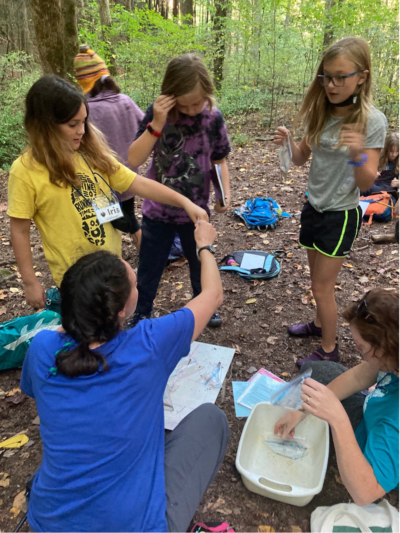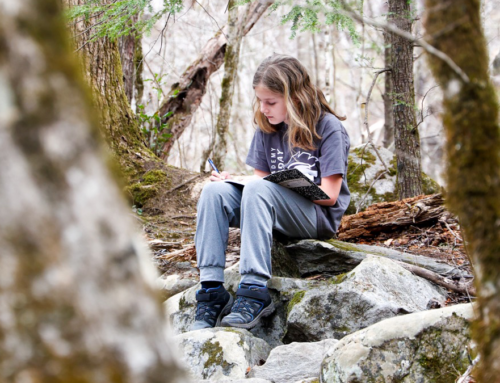Written by Annie Roth, Manager of the Teacher Network at Great Smoky Mountains Institute at Tremont
As teachers, we strive to bring meaningful learning experiences to our students, and often that takes us outside of the classroom. In the Schoolyard Network’s December call, educators from around the country shared ways that they are making class outings more intentional, especially when heading outdoors to learn about nature. A common theme for the conversation was the usefulness of pre- and post-trip experiences.
Whether you’re coming to Tremont’s campus for a field trip in the Smokies or you’re heading to your own schoolyard for an afternoon of exploration, the following tips from the Schoolyard Network can help make the experience more meaningful.
 The Pre-Trip : Logistics and Planning
The Pre-Trip : Logistics and Planning
- Have a bag to carry notebooks and pencils.
- Provide a place for students to sit comfortably. Consider sit pads if it’s cold or wet outside.
- Have that day on the calendar a few weeks ahead so students can get mentally prepared.
- Set boundaries and share your “call back” technique ahead of time for attention.
- Remind students of the purpose of the adventure and go over instructions while still indoors.
- Share: What makes them nervous about going out? Check in with who’s nervous.
- Ask: What should you do if you come across something unfamiliar/scary?
- Make sure everyone is dressed appropriately for the weather.
- Have a set gathering place where you start and finish.
- Practice moving in the outdoor areas before the students start tasks.
- Be sure to take a bathroom break ahead of time (and share when the next one will be).
- Let them know they will still have free play recess time later.
The Pre-Trip: Activities
- Make a “mind pie” to see where students stand on certain relevant topics ahead of time, and then repeat the same exercise after the outing to see where the students feel more confident or have improved.
- Do an “invite” activity that sparks curiosity.
- Bring the outdoors inside to spark students’ curiosity about nature. For example, bring in leaves and ask students to do the “I Notice, I Wonder, It Reminds Me Of” activity.
- Consider giving each venture outside a theme, such as predator/prey, pollinators, or colors.
- Watch the Tremont Weekly Wonder videos to get students excited about learning outdoors.
- Have students prepare their notebooks before heading outdoors so they can remember their specific purpose.
- Have students set goals – what are they hoping to get out of the experience?
- Invite students to make predictions – what do you think you will discover outside?
The Post-Trip: Reflecting
- Have students write reflections individually in a journal or as a group on butcher paper.
- Allow students time to reflect or add more to their journals.
- Have students journal about something they noticed or something that surprised them.
- Have students reflect by creating NART (nature art), such as these amazing creations from our Schoolyard Network in-person gathering last year.
- Compare and contrast findings.
- Journal – What could they do with their new learning? How does it relate to their own lives? What could be explored further?
- Journal about their opinion on the experience and where to go/what to do next.
- Write one amazing thing they did and one thing they felt they could have done better.
The Post-Trip: Sharing
- Find a place to display what they have discovered.
- Make a group list of all plants, animals, bugs, etc. you observed.
- Share photos from the experience.
- Graph any data collected and share your findings inside.
- Have students share their notebooks with people around them.
- Allow students to bring some (non-living) items back to the classroom if they feel connected to that item.
- Have students engage in a pair-share reflection. Questions could include, “How did it feel to be outside?” or “What was your biggest takeaway?”
- If students are excited to share, Show Call their notebooks under the document camera for the whole class to see.
- Consider having a classroom “bug hotel” – an aquarium or something similar that could temporarily house a bug, millipede, or even seeds or cones.
Interested in more educator content like this? Tap into a network of teachers and local resource providers during friendly, informal monthly professional development and sharing sessions. The Schoolyard Network will provide ideas and encouragement for you to take back to your classroom, focusing on better teaching and learning using the environment as an integrating concept. There is no cost to participate.




![A Deep Dive Into Wetlands [Free Lesson Plan]](https://gsmit.org/wp-content/uploads/2024/02/madeline-blog-cover-500x383.png)
![Are You a Math and Science Person or a History and English Person? [Free Lesson Plan]](https://gsmit.org/wp-content/uploads/2024/01/Girls-in-Science-Erin-Rosolina-3-1-500x383.jpg)

